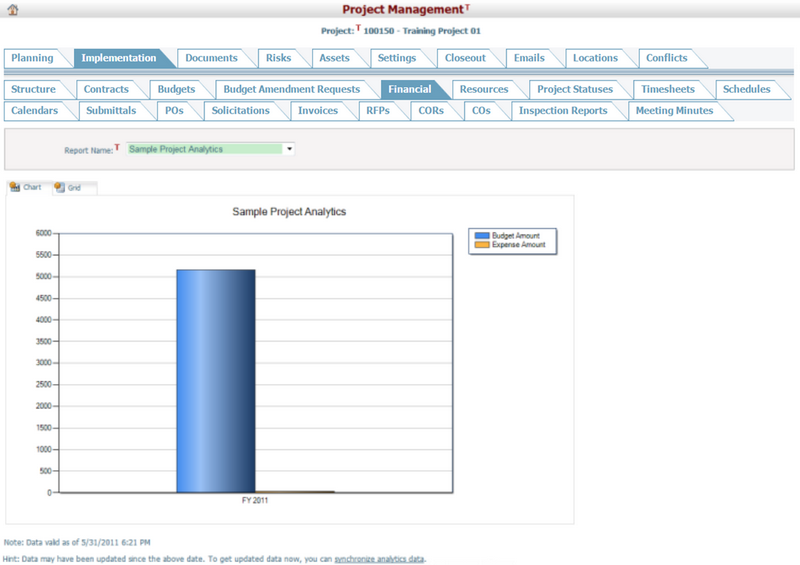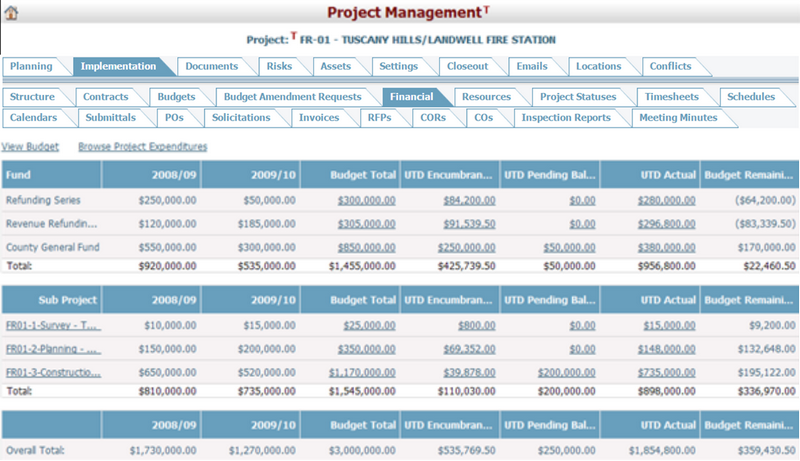Navigate Here: Projects > Browse Implementation Projects; select a Project > Click the Financial tab
The Financial tab page may vary depending on the configuration made during the implementation phase of your CIPAce product.
Case 1:
You can view the analytics reports published to the entity "Implementation Project".

The "Report Name" dropdown list shows the names of all analytics reports that have been published to the entity "Implementation Project". You can choose to view any of them.
Case 2:
You can browse the sum of budget and expenses for the current project on the Financial tab page.

Since there is project hierarchy structure in the system, the financial status will reflect differently according to different levels of projects.
Master project does not have its own budget and expense but summarizes the corresponding data from all its child projects, i.e. the planning-level project and sub-project under the planning-level project.
There are three tables displayed on the page. The first table outlines the sum of budget and expenses by fund for the master project itself but all data should be "zero". The second table outlines the sum of budget and expenses for all child projects under the master project, including the planning-level project and any sub project under the planning-level project. Each project is in a single record. The third table gives a summary of the budget and expenses outlined in the above tables. It is exactly the same as the Total data in table two.
Below are the descriptions of the content contained in Table Two:
1. The budget of the specific project is summarized by year and in total. You can click the Project ID-Project Name link and the system will open the Planning Project General page for the specific project in a new window. You can also click the Budget Total amount link and the system will open the Browse Budget Line Items page in a new window, where you can browse all budget line items of the specific project.
2. The expenses of the specific project are summarized by Expense Type:
UTD Encumbrance Balance: Calculated by Expense Amount minus Any Partial Payment Amount but the expense and payment must be approved. You can click the amount link and the system will go to the Search Project Expense Result page, where you can browse the encumbrance expenses in detail for the specific project.
UTD Pending Balance: Calculated by Expense Amount minus Any Partial Payment Amount but the expense and payment must be approved. You can click the amount link and the system will go to the Search Project Expense Result page, where you can browse the pending expenses in detail for the specific project.
UTD Actual: The sum of Actual Expenses and any partial payments of the Encumbrance and Pending expenses but the expense and payment must be approved. You can click the amount link and the system will go to the Search Project Expense Result page, where you can browse the actual expenses in detail for the specific project.
Budget Remaining: Calculated by Budget Total minus the sum of all expenses.
3. De-augmentation. When a project is closed with budget remaining, the budget will be returned to the corresponding fund(s) so the budget will be equal to the expenses. In this way, Budget Remaining will be "zero" and De-augmentation will be the amount of the original Budget Remaining but the number is negative.
You can click the View Budget link under the tabs and the system will go to the Browse Budget Line Items page, where you can browse all budget line items of the current project. Since the current project is a master project, no budget line item will be shown.
You can click the Browse Project Expenditures link under the tabs and the system will go to the Search Project Expense Result page, where you can browse all expenses in detail for all child projects under the master project. |
Planning-level projects / Sub-projects
Planning-level projects and sub-projects can have independent budget and expenses.
There are three tables displayed on the page.
The first table outlines the sum of budget and expenses by fund for the current project:
1. The budget is summarized by year and in total on a fund basis. You can click the Budget Total amount link and the system will open the Browse Budget Line Items page in a new window, where you can browse the budget line items by fund for the current project.
2. The expenses are summarized by Expense Type.
UTD Encumbrance Balance: Calculated by Expense Amount minus Any Partial Payment Amount but the expense and payment must be approved. You can click the amount link and the system will go to the Search Project Expense Result page, where you can browse the encumbrance expenses in detail for the current project.
UTD Pending Balance: Calculated by Expense Amount minus Any Partial Payment Amount but the expense and payment must be approved. You can click the amount link and the system will go to the Search Project Expense Result page, where you can browse the pending expenses in detail for the current project.
UTD Actual: The sum of Actual Expenses and any partial payments of the Encumbrance and Pending expenses but the expense and payment must be approved. You can click the amount link and the system will go to the Search Project Expense Result page, where you can browse the actual expenses in detail for the current project.
Budget Remaining: Calculated by Budget Total minus the sum of all expenses.
3. De-augmentation. When a project is closed with budget remaining, the budget will be returned to the corresponding fund(s) so that the budget will be equal to the expenses. In this way, Budget Remaining will be "zero" and De-augmentation will be the original amount of Budget Remaining but the number is negative.
The second table outlines the sum of budget and expenses of all child projects under the current project. Each project is in a single record. The descriptions of the content contained in Table Two are almost the same as that of Table One. You can click the Project ID-Project Name link in the table and the system will open the Planning Project General page for the specific project in a new window.
The third table gives a summary of the budget and expenses outlined in Table One and Table Two.
You can click the View Budget link under the tabs and the system will go to the Browse Budget Line Items page, where you can browse all budget line items of the current project.
You can click the Browse Project Expenditures link under the tabs and the system will go to the Search Project Expense Result page, where you can browse all expenses in detail for the current project and its child projects.
|